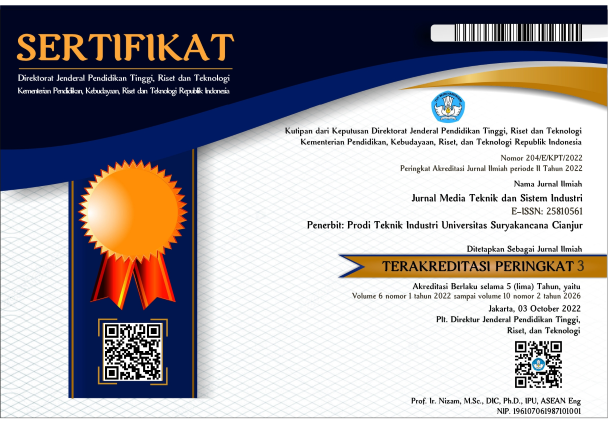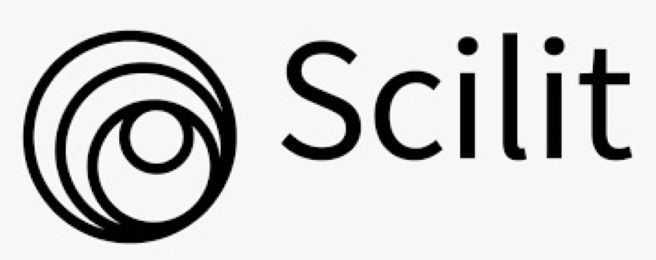Strategi Mitigasi Risiko Produktivitas Pada Proses Assembly Hospital Equipment
Abstract
The rapid development of technology and industrialization demands an increasing need for strategic planning. One of the strategies needed for a company to remain competitive in the industrialized world is to increase productivity. However, practically several companies still experience difficulties in making efforts to increase productivity so that the productivity achieved is not optimal. The same thing happened at PT. Mega Andalan Kalasan, especially on the Assembly Unit of the Hospital Equipment. Where the productivity achieved cannot be categorized as optimal because it can be seen from the number of non-value added activities that occur in assembly process. Among the products produced, it is known that the Operating Table Manual product has the highest percentage of non-value added activity, which is 30% of the total cycle time. This study aims to identify risks using the Failure Mode and Effect Analysis (FMEA) method and design a mitigation strategy as an initial effort to improve productivity by minimizing non-value added activities. The identification results show that there are 22 risks with moderate severity but high occurrence. Recommendations in the form of implementing better quality control on incoming materials are one of the strategies which capable of mitigating 40% of the risk of existing non value added activities.
Â
Adanya perkembangan teknologi dan industrialisasi yang semakin pesat menuntut kebutuhan akan perencanaan strategi semakin meningkat. Salah satu strategi yang dibutuhkan agar sebuah perusahaan dapat tetap bersaing di dunia perindustrian adalah dengan meningkatkan produktivitas. Namun pada penerapannya, beberapa perusahaan masih mengalami kesulitan dalam melakukan upaya peningkatan produktivitas sehingga produktivitas yang dicapai belum optimal. Hal yang serupa terjadi di PT. Mega Andalan Kalasan, khususnya pada lantai kerja Assembly unit Hospital Equipment. Dimana produktivitas yang dicapai belum bisa dikatakan optimal karena terlihat dari banyaknya non value added activity yang terjadi pada proses assembly. Diantara sejumlah produk yang dihasilkan, diketahui bahwa pengerjaan produk Operating Table Manual memiliki persentase non value added activity yang tertinggi yaitu sebanyak 30% dari total waktu siklusnya. Penelitian ini bertujuan untuk mengidentifikasi risiko dengan menggunakan metode Failure Mode and Effect Analysis (FMEA) dan merancang strategi mitigasi sebagai upaya awal untuk memperbaiki produktivitas dengan meminimalisir aktivitas non value added. Hasil identifikasi menunjukkan terdapat 22 risiko dengan tingkat severity sedang namun memiliki occurence yang tinggi. Rekomendasi berupa penerapan quality control yang lebih baik terhadap incoming material menjadi salah satu strategi yang mampu memitigasi 40% risiko aktivitas non value added yang ada.
Keywords
Full Text:
PDFReferences
D. Pujotomo och D. N. Rusanti, â€Usulan Perbaikan untuk Meningkatkan Produktivitas Filling Plant dengan Pendekatan Lean Manufacturing pada PT. SMART Tbk Surabaya,†Jurnal Teknik Industri, vol. X, 2015.
C. Ashmore, â€Kaizen-and The Art of Motorcycle Manufacture,†Engineering Management Journal, vol. 11, nr 5, pp. 211-214, 2001.
A. K. Dhingra, S. Kumal och B. Singh, â€Cost reduction and quality improvement through Lean-Kaizen concept using value stream map in Indian manufacturing firms,†International Journal of System Assurance Engineering and Management, vol. 10, nr 4, pp. 792-800, 2019.
W. Shou, J. Wang, P. Wu och X. Wang, â€Value Adding and Non-Value Adding Activities in Turnaround Maintenance Process: Classification, Validation, and Benefits,†Production Planning & Control, vol. 31, nr 1, pp. 60-77, 2020.
R. Griffin, Fundamentals of Management, Nelson Education, 2013.
C. Harland, R. Brenchley och H. Walker, â€Risk in Supply Network,†Journal of Purchasing and Supply Management, vol. 9, nr 2, pp. 51-62, 2003.
R. J. Mikulak, R. McDermott och M. Beauregard, The Basic of FMEA, CRC Press, 2017.
H.-C. Liu, FMEA using uncertainty theories and MCDM methods., Singapore: Springer, 2016, pp. 13-27.
W. Jiang, C. Xie, M. Zhuang och Y. Tang, â€Failure mode and effects analysis based on a novel fuzzy evidential method.,†Applied Soft Computing, vol. 57, pp. 672-683, 2017.
H. Firdaus och T. Widianti, â€Failure mode and effect analysis (FMEA) sebagai Tindakan Pencegahan pada Kegagalan Pengujian,†Lembaga Ilmu Pengetahuan Indonesia, Pusat Penelitian Sistem Mutu dan Teknologi Pengujian, Banten, 2015.
T. Henkey, Urban emergency management: planning and response for the 21st Century, Butterworth-Heinemann, 2017.
DOI: https://doi.org/10.35194/jmtsi.v5i1.1214
Refbacks
- There are currently no refbacks.

This Journal is licensed under a Creative Commons Attribution-ShareAlike 4.0 International License.
Jurnal Media Teknik dan Sistem Industri ISSN: 2581-0561 (online); 2581-0529 (cetak).
Gedung Fakultas Teknik UNSUR Jl. Pasir Gede Raya, Cianjur, Jawa Barat 43216| Telp./Fax. (0263) 283578 |E-mail: jmtsi@unsur.ac.id
JMTSI (Jurnal Media Teknik dan Sistem Industri) INDEXED BY :


















